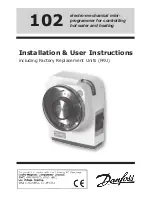
11-1
EB 31a_EN
December 2022 edition
Subject to technical changes
Removal
11
Removal
The work described in this chapter may only be performed by
specialist personnel quali
fi
ed to perform the corresponding task.
Risk of bursting due to improper opening of pressurised devic-
es and components!
Pneumatic rotary actuators are pressure equipment that can burst
if handled improperly. Projecting,
fl
ying components and frag-
ments can cause injuries or even death.
Before working on the actuator:
Ö
Depressurise the concerned plant parts and the actuator. Also
residual energy must be discharged.
Danger of injury due to preloaded springs!
The rotary actuators are tensioned due to the compressed
springs. Furthermore, improper disassembly of the spring car-
tridge can lead to serious injuries.
Open the rotary actuator only according to the instructions, see
Chapter “11.1 Releasing the spring tension in the actuator”.
Danger due to escaping exhaust air!
The actuator is pneumatically operated, therefore exhaust air
escapes after it is controlled.
Ö
When working near the actuator, wear eye and hearing
protection.
Danger of crushing due to moving actuator- and switching
shaft!
Ö
Before working on the actuator, interrupt and lock pneumatic
energy and the control signal.
Ö
Vent the actuator.
Ö
Do not allow the jamming of objects to hinder the operation
of the actuator- and switching shaft.
Ö
If the actuator- and switching shaft are blocked (e.g. due to
“seizure” if not actuated for a long period of time”), release
the residual energy of the actuator (spring tension) before re-
leasing the blockage, see Chapter “11.1 Releasing the spring
tension in the actuator”.
Prior to disassembly, make sure that the following conditions are
met:
−
The actuator is decommissioned, see chapter “10 Decommis-
sioning”.
DANGER
WARNING
11.1 Releasing the spring tension in the
actuator
The end caps (22 and 23) are tensioned due to the compressed
springs. Furthermore, improper disassembly of the spring car-
tridge can lead to serious injuries.
Ö
Before starting work on the rotary actuator, disconnect all
pneumatic, hydraulic and electrical supply lines.
Ö
Depressurise the rotary actuator.
Ö
When disassembling the end cap, bring the rotary actuator
to the “closed” (0°) position and remove the fastening screws
correctly.
Ö
Disassemble one end cap after the other.
.
Danger of damage to components due to incorrect
disassembly!
During disassembly, the compressed springs can be damaged
due to the uneven application of force.
Ö
When disassembling the end cap screws, observe the order,
see Figure 11-1.
Ö
When disassembling the end cap, maintain a constant
distance (A = B) between the actuator housing and the
housing interface, see Figure 11-2.
Figure
|
11-1:
Disassembling the end cap screws
WARNING
Содержание EB 31a
Страница 6: ...EB 31a_EN December 2022 edition Subject to technical changes Content...
Страница 10: ...1 4 EB 31a_EN December 2022 edition Subject to technical changes Safety instructions and safety measures...
Страница 26: ...4 6 EB 31a_EN December 2022 edition Subject to technical changes Shipment and on site transport...
Страница 32: ...6 2 EB 31a_EN December 2022 edition Subject to technical changes Start up...
Страница 34: ...7 2 EB 31a_EN December 2022 edition Subject to technical changes Operation...
Страница 42: ...9 6 EB 31a_EN December 2022 edition Subject to technical changes Servicing...
Страница 44: ...10 2 EB 31a_EN December 2022 edition Subject to technical changes Decommissioning...
Страница 52: ...13 2 EB 31a_EN December 2022 edition Subject to technical changes Disposal...
Страница 54: ...14 2 EB 31a_EN December 2022 edition Subject to technical changes Certificates...
Страница 55: ...14 3 EB 31a_EN December 2022 edition Subject to technical changes Certificates...
Страница 56: ...14 4 EB 31a_EN December 2022 edition Subject to technical changes Certificates...
Страница 67: ...EB 31a_EN December 2022 edition Subject to technical changes...
















































